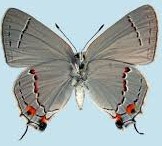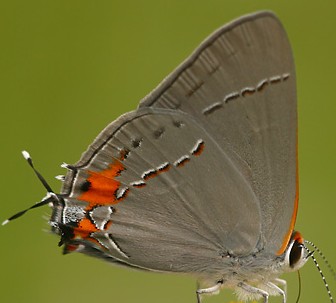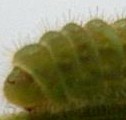 The gray hairstreak is one of the most widely distributed butterflies in the US being absent only from the far North. They prefer open sunny sights such as coastal areas, chaparral, old fields, parks, vacant lots, and roadsides. The dorsal side is deep slate gray with an orange spot on the hindwing near the tail. The ventral side is dove-gray with a straight, thin straight white mid-band is bordered by orange on the inside edge. Heads usually have an orange patch and the abdomens of males often have orange sides. The wingspan is 7/8 to 1 3/8 inches.
The gray hairstreak is one of the most widely distributed butterflies in the US being absent only from the far North. They prefer open sunny sights such as coastal areas, chaparral, old fields, parks, vacant lots, and roadsides. The dorsal side is deep slate gray with an orange spot on the hindwing near the tail. The ventral side is dove-gray with a straight, thin straight white mid-band is bordered by orange on the inside edge. Heads usually have an orange patch and the abdomens of males often have orange sides. The wingspan is 7/8 to 1 3/8 inches.
 Males look for females in the afternoon perched on the leaves of bushes and small trees. After mating females deposit pale green eggs singly on the flowers and buds of host plants.
Males look for females in the afternoon perched on the leaves of bushes and small trees. After mating females deposit pale green eggs singly on the flowers and buds of host plants.  The caterpillars that emerge are variable in color but are usually grass green with white to mauve diagonal side stripes. They are known as “cotton square borers” and sometimes damaged commercial bean, hops, and cotton crops. Caterpillars pupate on the ground forming a brown chrysalis mottled with black that is covered with debris by ants.
The caterpillars that emerge are variable in color but are usually grass green with white to mauve diagonal side stripes. They are known as “cotton square borers” and sometimes damaged commercial bean, hops, and cotton crops. Caterpillars pupate on the ground forming a brown chrysalis mottled with black that is covered with debris by ants.
Both larvae and adults eat a wide variety of foods. The larvae prefer plants from the Fabaceae (pea) and Malvaceae (mallow) families including beans (Phaseolus), clovers (Trifolium), cotton (Gossypium), and mallow (Malva). Good garden plants include Hibisucus spp., hollyhock (Malva alcea), and passionflower (Passiflora incarnata). The adults nectar on many flower species including dogbane (Apocynum cannabinum), winter cress (Barbarea vulgaris), tick trifoil (Desmodium), blood flower (Asclepias curassavica,), butterfly milkweed (Asclepias tuberosa), common milkweed (Asclepias syriaca), swamp milkweed (Ascelpias incarnata), Queen Anne’s lace (Daucus carota), goldenrod, and white sweet clover (Melilotus albus). Of these, golden rod, butterfly milkweed, and swamp milkweed are the best choices for the formal garden. The others are best planted in a wildflower garden.